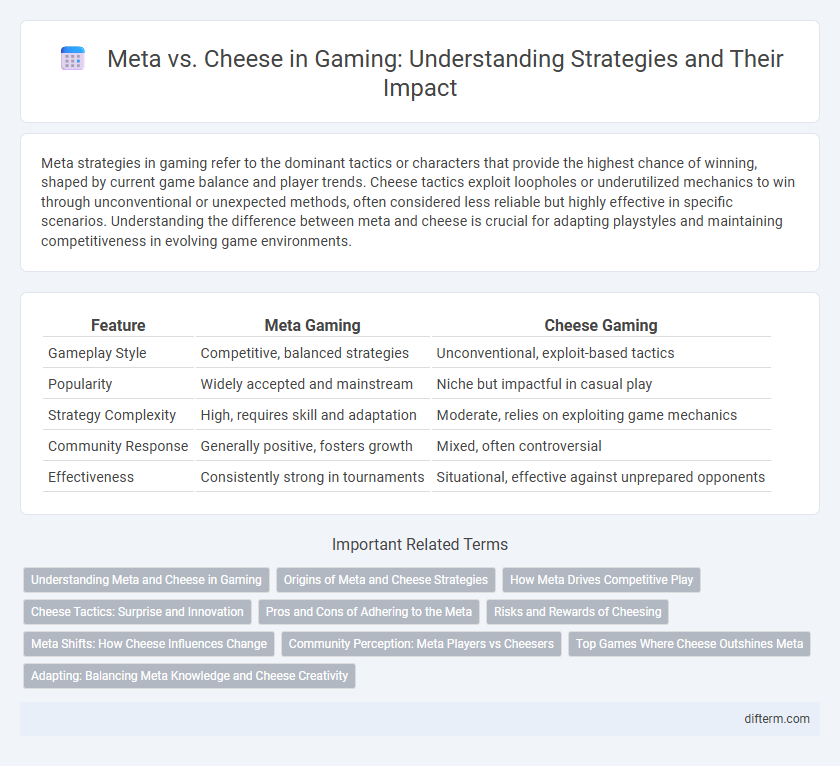Meta strategies in gaming refer to the dominant tactics or characters that provide the highest chance of winning, shaped by current game balance and player trends. Cheese tactics exploit loopholes or underutilized mechanics to win through unconventional or unexpected methods, often considered less reliable but highly effective in specific scenarios. Understanding the difference between meta and cheese is crucial for adapting playstyles and maintaining competitiveness in evolving game environments.
Table of Comparison
| Feature | Meta Gaming | Cheese Gaming |
|---|---|---|
| Gameplay Style | Competitive, balanced strategies | Unconventional, exploit-based tactics |
| Popularity | Widely accepted and mainstream | Niche but impactful in casual play |
| Strategy Complexity | High, requires skill and adaptation | Moderate, relies on exploiting game mechanics |
| Community Response | Generally positive, fosters growth | Mixed, often controversial |
| Effectiveness | Consistently strong in tournaments | Situational, effective against unprepared opponents |
Understanding Meta and Cheese in Gaming
Meta in gaming represents the most effective strategies, characters, or tactics that dominate the current competitive environment due to their high success rates and popularity. Cheese refers to unconventional or surprising tactics designed to catch opponents off-guard, often exploiting overlooked game mechanics or meta weaknesses. Mastery of both meta strategies and cheese tactics can greatly enhance a player's adaptability and effectiveness in competitive gameplay.
Origins of Meta and Cheese Strategies
Meta strategies in gaming emerge from dominant, optimized tactics that consistently deliver high win rates, shaping the competitive landscape by setting standardized playstyles. Cheese strategies originate as unconventional, high-risk maneuvers designed to surprise opponents and disrupt the predictable flow of the meta by exploiting game mechanics or overlooked interactions. Both concepts drive dynamic strategic evolution, with meta fostering refined efficiency and cheese promoting innovation through unexpected gameplay.
How Meta Drives Competitive Play
Meta gaming shapes competitive play by defining optimal strategies and character choices based on current game mechanics and balance patches. Players analyze win rates, pick rates, and tier lists to adapt and counter prevailing tactics within tournaments and ranked matches. This data-driven approach fosters a dynamic environment where innovation challenges established metas, driving skill advancement and strategic depth.
Cheese Tactics: Surprise and Innovation
Cheese tactics in gaming involve unconventional strategies that catch opponents off guard, leveraging surprise and rapid innovation to disrupt meta gameplay norms. These approaches prioritize unexpected moves and creative unit compositions, forcing adversaries to adapt quickly or face defeat. Employing cheese tactics can create significant advantages by exploiting weaknesses in well-established meta strategies.
Pros and Cons of Adhering to the Meta
Adhering to the meta in gaming offers strategic advantages such as optimized character builds, proven tactics, and higher chances of winning due to extensive community testing and balancing updates. However, strict adherence can limit creativity, reduce adaptability against unconventional opponents, and make gameplay predictable, potentially leading to stagnation. Players who balance meta strategies with innovative approaches tend to maintain competitive edges while enjoying a more dynamic experience.
Risks and Rewards of Cheesing
Cheesing in gaming exploits predictable strategies to secure quick wins but carries the risk of countering tactics that can lead to rapid defeat. Players using cheese often gain short-term advantages through surprise or unconventional maneuvers, yet overreliance can diminish adaptability and skill development. Balancing cheese with solid gameplay helps mitigate potential losses while maximizing the element of strategic surprise.
Meta Shifts: How Cheese Influences Change
Cheese strategies in gaming prompt significant meta shifts by introducing unexpected, high-reward tactics that force players to adapt their core strategies. These unconventional methods exploit game mechanics or character abilities in innovative ways, altering competitive balance and driving iterative changes in player behavior and patch updates. As a result, meta evolves dynamically, reflecting the ongoing interplay between standard optimal play and disruptive cheese tactics.
Community Perception: Meta Players vs Cheesers
Meta players are often perceived by the gaming community as skilled and strategic, mastering widely accepted game mechanics to optimize performance. Cheesers, however, are viewed less favorably due to their reliance on exploitative tactics that may circumvent intended gameplay balance. This divide fosters ongoing debates about fairness, skill, and enjoyment within competitive gaming environments.
Top Games Where Cheese Outshines Meta
In competitive gaming, cheese strategies often disrupt the expected meta by leveraging unconventional tactics and irregular unit compositions that catch opponents off guard. Titles such as StarCraft II, Age of Empires II, and Dota 2 showcase numerous instances where aggressive or cheesy plays outperform standard meta builds by exploiting timing attacks or obscure mechanics. These strategies challenge the meta by introducing unpredictable elements, forcing players to adapt quickly and rethink rigid gameplay patterns.
Adapting: Balancing Meta Knowledge and Cheese Creativity
Balancing meta knowledge and cheese creativity offers a competitive edge by combining proven strategies with unexpected tactics that catch opponents off guard. Successful gamers adapt by analyzing meta trends while innovatively incorporating unconventional plays to disrupt standard gameplay. This dynamic approach enhances adaptability, ensuring players remain unpredictable and resilient in fast-evolving gaming environments.
Meta vs Cheese Infographic

 difterm.com
difterm.com